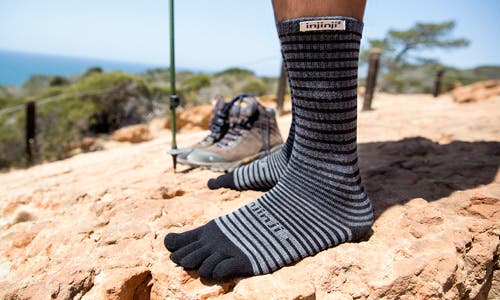When someone says the words “wool socks” to you, what do you imagine? If it’s a pair of thick, scratchy things you were forced to wear when it was cold outside, you’re not alone. But if that’s all you know wool as, you’re missing out! From trail running to tee time, wool is a wonder material for just about everyone.

W is for Wicking
We hear about moisture-wicking technology all the time. It’s a staple for athletic apparel, since active people tend to perspire a bit (or a lot). Active wear is often a blend of synthetic fibers whose goal is to keep you dry and at the optimum temperature for performance. But do you know what the original wicking material was? Wool.
This old faithful for keeping you dry while you work has been used for millennia by people all over the world. Wool’s secret is in its fibers. Made of cortical cells wrapped in layers of water-resistant cuticle, each tiny fiber has a crimp to it, forcing the fibers to lay against each other unevenly. The resulting zigzag pattern creates pockets of air in-between fibers, which allows moisture to be drawn from your skin into the wool material. And you don’t have to worry about feeling damp (in most conditions) when wearing wool—it can absorb up to 30% of its weight in water.
Not Too Hot, Not Too Cold
The beauty of a naturally wicking fiber is that it not only keeps you dry, it keeps your temperature regulated. Using air pockets formed by the crimps in each wool fiber, the fabric naturally retains heat. Depending on the diameter of the fiber, there are more crimps, creating more insulating ability. Paired with the slow absorption of moisture from your skin, wool fibers and their structure have the power to keep you comfortable in a wide variety of temperatures.
Just Right for You
There’s a wool out there for almost any activity—and in any thickness. From lightweight wool to keep you cool to heavy sweaters you need to stay warm, wool has got your back. It comes blended with other fibers so you can tailor your clothes to your activities, and it even comes in non-scratchy varieties! Merino wool is smooth and comfortable, making it possible to almost forget you’re wearing something other than a cotton blend. While it can run a little more expensive, the benefits of wearing wool far outweigh the costs.
Sources:
http://www.merino.com/wool/the-fibre/how-to-beat-the-heat-in-merino-wool/
http://www.outdoors.org/articles/amc-outdoors/the-science-behind-wools-powers-2/
http://adventure.howstuffworks.com/outdoor-activities/hiking/wool-when-wet1.htm








